Storing Grain in the Land: The Gestation, Delineation Framework, and Case of the Two Zones Policy in China
Abstract
1. Introduction
2. The Gestation of the Two Zones Policy
2.1. Evolution of CL Protection Policy in China
2.1.1. Quantity Protection Period (1983–1997)
2.1.2. Quantity–Quality Coupling Period (1998–2011)
2.1.3. Trinity of Quantity, Quality, and Structure (2012–Present)
2.2. Restoring Grain on Land: Interpretation of the Two Zones Policy
2.2.1. Three Dimensions of Quantity, Quality, and Structure
2.2.2. Essence: Spatial Control and Regional Layout Optimization
3. Framework and Methods
3.1. Framework and Processing
3.2. Methods
3.2.1. LESA System
3.2.2. Getis–Ord Gi*Statistics
3.2.3. Constraint Conditions
4. Case of Qianguo County
4.1. Case Area
4.2. Data Sources and Processing
4.3. Results of the Delineation
4.3.1. LESA System
4.3.2. Cultivation Priority Planning Results
4.4. Regional Division of the Potential Types
4.5. Two Zone Delineation Results
5. Discussion
5.1. CL Protection Systems in Developed and Developing Countries
5.2. Linkage between CL Protection and the Grain Security System
5.3. From County to Country
5.4. Contributions and Limitations
6. Conclusions
Author Contributions
Funding
Institutional Review Board Statement
Informed Consent Statement
Data Availability Statement
Acknowledgments
Conflicts of Interest
Abbreviations
References
- Gao, L.; Bryan, B.A. Finding pathways to national-scale land-sector sustainability. Nature 2017, 544, 217–222. [Google Scholar] [CrossRef]
- Ministry of Natural of the People’s Republic of China. Press Conference on The Results of The National Cultivated Land Reserve Resources Survey [N/OL]. Available online: http://www.mnr.gov.cn/dt/zb/2016/gd/ (accessed on 28 December 2016).
- Zhu, D.; Chen, W.; Qu, X.; Zheng, Y.; Bi, J.; Kan, H.; Luo, Y.; Ying, G.; Zeng, E.Y.; Zhao, F.; et al. Future research needs for environmental science in China. Geogr. Sustain. 2021, 2, 234–242. [Google Scholar] [CrossRef]
- Cheng, L.; Jiang, P.; Chen, W.; Li, M.; Wang, L.; Gong, Y.; Pian, Y.; Xia, N.; Duan, Y.; Huang, Q. Farmland protection policies and rapid urbanization in China: A case study for changzhou city. Land Use Policy 2015, 48, 552–566. [Google Scholar]
- Bhopal, A.; Blanchard, K.; Weber, R.; Murray, V. Disasters and food security: The impact on health. Int. J. Disaster Risk Reduct. 2018, 33, 1–4. [Google Scholar] [CrossRef]
- Klomp, J.; Hoogezand, B. Natural disasters and agricultural protection: A panel data analysis. World Dev. 2018, 104, 404–417. [Google Scholar] [CrossRef]
- Pu, M.; Zhong, Y. Rising concerns over agricultural production as COVID-19 spreads: Lessons from China. Glob. Food Secur. 2020, 26, 100409. [Google Scholar] [CrossRef]
- Oczkowskie, E.; Bandara, Y. Modelling agricultural land use allocation in regional Australia. Aust. J. Agric. Resour. Econ. 2013, 57, 422–440. [Google Scholar] [CrossRef]
- Liu, Y.; Li, Y. Revitalize the world’s countryside. Nature 2017, 548, 275–277. [Google Scholar] [CrossRef]
- Spyra, M.; Kleemann, J.; Calò, N.C.; Schürmann, A.; Fürst, C. Protection of peri-urban open spaces at the level of regional policy-making: Examples from six European regions. Land Use Policy 2021, 107, 105480. [Google Scholar] [CrossRef]
- Gao, C.L.; Wei, H.K. Prediction study on the urbanization trends of China. Mod. Econ. Sci. 2013, 35, 85e90. [Google Scholar]
- Long, H.L.; Ge, D.Z.; Zhang, Y.N.; Tu, S.; Qu, Y.; Ma, L. Changing man-land interrelations in China’s farming area under urbanization and its implications for food security. J. Environ. Manag. 2018, 209, 440–451. [Google Scholar] [CrossRef]
- Cullingworth, J.B.; Nadin, V. Town and Country Planning in the UK; Psychology Press: New York, NY, USA, 2002. [Google Scholar]
- Pahl-Weber, E.; Henckel, D. The Planning System and Planning Terms in Germany: A Glossary; Akademie for Raumforschung Und Landesplanung, Hanover: Worcester, MA, USA, 2008; pp. 121–185. [Google Scholar]
- Liu, X.W.; Zhao, C.L.; Song, W. Review of the evolution of cultivated land protection policies in the period following China’s reform and liberalization. Land Use Policy 2017, 67, 660–669. [Google Scholar] [CrossRef]
- Zhou, W.B.; Duan, F.Y. Closing crop yield and efficiency gaps for food security and sustainable agriculture. J. Integr. Agric. 2021, 20, 343–348. [Google Scholar] [CrossRef]
- Song, W.; Pijanowski, B.C. The effects of China’s cultivated land balance program on potential land productivity at a national scale. Appl. Geogr. 2014, 46, 158–170. [Google Scholar] [CrossRef]
- Wu, Y.Z.; Shan, L.P.; Guo, Z.; Peng, Y. Cultivated land protection policies in China facing 2030, Dynamic balance system versus basic farmland zoning. Habitat Int. 2017, 69, 126–138. [Google Scholar] [CrossRef]
- Zhao, Y.L. Statistical analysis of the changes of cultivated land resources in the past 10 years. Territ. Nat. Resour. Study 2020, 1, 53–57. [Google Scholar]
- Liu, T.; Liu, H.; Qi, Y.J. Construction land expansion and cultivated land protection in urbanizing China: Insights from national land surveys, 1996–2006. Habitat Int. 2015, 46, 13–22. [Google Scholar] [CrossRef]
- Yang, S.L.; Wang, H.M.; Tong, J.P.; Bai, Y.; Alatalo, J.M.; Liu, G.; Fang, Z.; Zhang, F. Impacts of environment and human activity on grid-scale land cropping suitability and optimization of planting structure, measured based on the MaxEnt model. Sci. Total Environ. 2022, 836, 155356. [Google Scholar] [CrossRef] [PubMed]
- Wu, Y.Z.; Zhang, X.L.; Skitmore, M.; Song, Y.; Hui, E.C.M. Industrial land price and its impact on urban growth: A Chinese case study. Land Use Policy 2014, 36, 199–209. [Google Scholar] [CrossRef]
- Cheng, Q.; Jiang, P.; Cai, L.; Shan, J.; Zhang, Y.; Wang, L.; Li, M.; Li, F.; Zhu, A.; Chen, D. Delineation of a permanent basic farmland protection area around a city centre: Case study of Changzhou City, China. Land Use Policy 2017, 60, 73–89. [Google Scholar]
- He, J.; Guan, X.; Yu, Y. A Modeling Approach for Farmland Protection Zoning Considering Spatial Heterogeneity: A Case Study of E-Zhou City, China. Sustainability 2016, 8, 1052. [Google Scholar] [CrossRef]
- Zhang, R.; Li, J.; Du, Q.; Ren, F. Basic farmland zoning and protection under spatial constraints with a particle swarm optimisation multiobjective decision model: A case study of Yicheng, China. Environ. Plan. B-Plan. Des. 2015, 42, 1098–1123. [Google Scholar] [CrossRef]
- Chen, Y.; Yao, M.; Zhao, Q.; Chen, Z.; Jiang, P.; Li, M.; Chen, D. Delineation of a basic farmland protection zone based on spatial connectivity and comprehensive quality evaluation: A case study of Changsha City, China. Land Use Policy 2021, 101, 105145. [Google Scholar] [CrossRef]
- Cai, W.; Yan, H.; Shi, Y. Research of the Basic Farmland Delimitation Based on Fuzzy Decision-making Model. In Proceedings of the 5th International Conference on Management of Technology, Taiyuan, China, 20–23 August 2010; pp. 198–203. [Google Scholar]
- Kuang, L.; Ye, Y.; Zhao, X.; Guo, X.; Xie, W. Delineation of basic farmland based on the quality and spatial stability: A case study of Yingtan City, China. Environ. Sci. Pollut. Res. 2022, 29, 88737–88750. [Google Scholar] [CrossRef] [PubMed]
- Jiang, P.H.; Li, M.C.; Sheng, Y. Spatial regulation design of farmland landscape around cities in China: A case study of Changzhou City. Cities 2020, 97, 102504. [Google Scholar] [CrossRef]
- Liu, Y.L.; Liu, L.; Zhu, A.X.; Lao, C.H.; Hu, G.H.; Hu, Y.M. Scenario farmland protection zoning based on production potential: A case study in China. Land Use Policy 2020, 95, 104581. [Google Scholar] [CrossRef]
- Sari, F.; Sari, F.K. Multi criteria decision analysis to determine the suitability of agricultural crops for land consolidation areas. Int. J. Eng. Geosci. 2021, 6, 64–73. [Google Scholar] [CrossRef]
- Tseganeh, B.; Sehra, P.S.; Sood, A. Land suitability analysis for agricultural crops using GIS and remote sensing techniques. J. Agrometeorol. 2008, 10, 67–71. [Google Scholar]
- Song, G.; Zhang, H.M. Cultivated Land Use Layout Adjustment Based on Crop Planting Suitability: A Case Study of Typical Counties in Northeast China. Land 2021, 10, 107. [Google Scholar] [CrossRef]
- Li, P.; Shi, K.; Wang, Y.Y.; Kong, D.N.; Liu, T.; Jiao, J.G.; Liu, M.Q.; Li, H.X.; Hu, F. Soil quality assessment of wheat-maize cropping system with different productivities in China: Establishing a minimum data set. Soil Tillage Res. 2019, 190, 31–40. [Google Scholar] [CrossRef]
- Seyedmohammadi, J.; Sarmadian, F.; Jafarzadeh, A.A.; Ghorbani, M.A.; Shahbazi, F. Application of SAW, TOPSIS and fuzzy TOPSIS models in cultivation priority planning for maize, rapeseed and soybean crops. Geoderma 2018, 310, 178–190. [Google Scholar] [CrossRef]
- Braun, A.B.; Trentin, A.W.D.; Visentin, C.; Thome, A. Proposal for an optimized method for sustainable remediation evaluation and application: Implementation of a multi-criteria process. Environ. Sci. Pollut. Res. 2019, 26, 35996–36006. [Google Scholar] [CrossRef] [PubMed]
- Dung, E.J.; Sugumaran, R. Development of an agricultural land evaluation and site assessment (LESA) decision support tool using remote sensing and geographic information system. J. Soil Water Conserv. 2005, 60, 228–235. [Google Scholar]
- Hoobler, B.M.; Vance, G.F.; Hamerlinck, J.D.; Munn, L.C.; Hayward, J.A. Applications of land evaluation and site assessment (LESA) and a geographic information system (GIS) in East Park County, Wyoming. J. Soil Water Conserv. 2003, 58, 105–112. [Google Scholar]
- Qian, F.; Lal, R.; Wang, Q. Land evaluation and site assessment for the basic farmland protection in Lingyuan County, Northeast China. J. Clean. Prod. 2021, 314, 128097. [Google Scholar] [CrossRef]
- Qian, F.K.; Wang, W.W.; Wang, Q.B.; Lal, R. Implementing land evaluation and site assessment (LESA system) in farmland protection: A case-study in northeastern China. Land Degrad. Dev. 2021, 32, 2437–2452. [Google Scholar] [CrossRef]
- Steiner, F.; Dunford, R.; Dosdall, N. The Use of the Agricultural Land Evaluation and Site Assessment System in the United-States. Landsc. Urban Plan. 1987, 14, 183–199. [Google Scholar] [CrossRef]
- Esmaeili, E.; Shahbazi, F.; Sarmadian, F.; Jafarzadeh, A.A.; Hayati, B. Land capability evaluation using NRCS agricultural land evaluation and site assessment (LESA) system in a semi-arid region of Iran. Environ. Earth Sci. 2021, 80, 1–4. [Google Scholar] [CrossRef]
- Nosrati, K.; Collins, A.L. A soil quality index for evaluation of degradation under land use and soil erosion categories in a small mountainous catchment, Iran. J. Mt. Sci. 2019, 16, 2577–2590. [Google Scholar] [CrossRef]
- Ying, Z. Collection of Current Policies and Laws of Land Management; Present China Press: Beijing, China, 2004; pp. 25–182. [Google Scholar]
- Zhang, M.; Liu, Y.; Wu, J.; Wang, T. Index system of urban resource and environment carrying capacity based on ecological civilization. Environ. Environ. Impact Assess. Rev. 2018, 68, 90–97. [Google Scholar] [CrossRef]
- Huang, D.Q.; Jin, H.R.; Zhao, X.S.; Liu, S.H. Factors influencing the conversion of arable land to urban use and policy implications in Beijing, China. Sustainability 2015, 7, 180–194. [Google Scholar] [CrossRef]
- Li, X.Y.; Liu, N.J.; You, L.Z.; Ke, X.L.; Liu, H.J.; Huang, M.L.; Waddington, S.R. Patterns of cereal yield growth across China from 1980 to 2010 and their implications for food production and food security. PLoS ONE 2016, 11, e0159061. [Google Scholar] [CrossRef] [PubMed]
- Mao, L.X.; Zhao, J.F.; Xu, L.L.; Yan, H.; Li, S.; Li, Y.F. Climatic suitability of spring maize planted in the “sickle bend” area of China and regulation suggestion. J. Appl. Ecol. 2016, 27, 3935–3943. [Google Scholar]
- Zhang, Y.; Dong, S.; Gao, Q.; Liu, S.; Zhou, H.; Ganjurjav, H.; Wang, X. Climate change and human activities altered the diversity and composition of soil microbial community in alpine grasslands of the Qinghai-Tibetan Plateau. Sci. Total Environ. 2016, 562, 353–363. [Google Scholar] [CrossRef]
- Daniels, T. Using Lesa in a Purchase of Development Rights Program. J. Soil Water Conserv. 1990, 45, 617–621. [Google Scholar]
- Akinci, H.; Ozalp, A.Y.; Turgut, B. Agricultural land use suitability analysis using GIS and AHP technique. Comput. Electron. Agric. 2013, 97, 71–82. [Google Scholar] [CrossRef]
- Memarbashi, E.; Azadi, H.; Barati, A.A.; Mohajeri, F.; Van Passel, S.; Witlox, F. Land-Use Suitability in Northeast Iran: Application of AHP-GIS Hybrid Model. ISPRS Int. J. Geo-Inf. 2017, 6, 396. [Google Scholar] [CrossRef]
- Mokarram, M.; Mirsoleimani, A. Using Fuzzy-AHP and order weight average (OWA) methods for land suitability determination for citrus cultivation in ArcGIS (Case study: Fars province, Iran). Physica A 2018, 508, 506–518. [Google Scholar] [CrossRef]
- Aydi, A.; Abichou, T.; Nasr, I.H.; Louati, M.; Zairi, M. Assessment of land suitability for olive mill wastewater disposal site selection by integrating fuzzy logic, AHP, and WLC in a GIS. Environ. Monit. Assess. 2016, 188, 1–3. [Google Scholar] [CrossRef]
- Hassan, I.; Javed, M.A.; Asif, M.; Luqman, M.; Ahmad, S.R.; Ahmad, A.; Akhtar, S.; Hussain, B. Weighted Overlay Based Land Suitability Analysis of Agriculture Land in Azad Jammu and Kashmir Using Gis and Ahp. Pak. J. Agric. Sci. 2020, 57, 1509–1519. [Google Scholar]
- El Baroudy, A.A.; Ali, A.M.; Mohamed, E.S.; Moghanm, F.S.; Shokr, M.S.; Savin, I.; Poddubsky, A.; Ding, Z.L.; Kheir, A.M.S.; Aldosari, A.A.; et al. Modeling Land Suitability for Rice Crop Using Remote Sensing and Soil Quality Indicators: The Case Study of the Nile Delta. Sustainability 2020, 12, 9653. [Google Scholar] [CrossRef]
- He, W.Y.; Yang, S.; Guo, R.; Chen, Y.X.; Zhou, W.H.; Jia, C.J.; Sun, G.J. GIS-Based Evaluation of Soybean Growing Areas Suitability in China. Comput. Comput. Technol. Agric. 2011, 346, 357–366. [Google Scholar]
- Kihoro, J.; Bosco, N.J.; Murage, H. Suitability analysis for rice growing sites using a multicriteria evaluation and GIS approach in great Mwea region, Kenya. SpringerPlus 2013, 2, 1–9. [Google Scholar] [CrossRef]
- Li, L.; Li, X.F.; Zheng, X.M. Research on Water Suitability of Maize Planting Range in Northeast China. In Proceedings of the IGARSS 2020–2020 IEEE International Geoscience and Remote Sensing Symposium, Waikoloa, HI, USA, 26 September–2 October 2020; pp. 5022–5025. [Google Scholar]
- Moya-Raygoza, G.; Figueroa-Bautista, P. Suitability of Hybrid and Landrace Maize Plants Within Conventional and Organic-Polyculture Maize Agroecosystems for Hosting Parasitic Wasps. Ann. Entomol. Soc. Am. 2021, 114, 750–755. [Google Scholar] [CrossRef]
- Radocaj, D.; Jurisic, M.; Plascak, I.; Barac, Z.; Zimmer, D. Cropland suitability determination for maize (Zea mays L.) using multilevel GIS-based multicriteria analysis in continental Croatia. J. Cent. Eur. Agric. 2021, 22, 636–645. [Google Scholar] [CrossRef]
- Rahim, S.E.; Supli, A.A.; Damiri, N. Suitability evaluation tool for lands (Rice, Corn and Soybean) as mobile application. AIP Conf. Proc. 2017, 1885, 020312. [Google Scholar]
- Ramamurthy, V.; Reddy, G.P.O.; Kumar, N. Assessment of land suitability for maize (Zea mays L.) in semi-arid ecosystem of southern India using integrated AHP and GIS approach. Comput. Electron. Agric. 2020, 179, 105806. [Google Scholar] [CrossRef]
- Jenks, G.F. Visualizing Statistical Distributions and Generalizing Process. Ann. Assoc. Am. Geogr. 1967, 57, 179. [Google Scholar]
- Getis, A.; Ord, J.K. The Analysis of Spatial Association by Use of Distance Statistics. Geogr. Anal. 1992, 24, 189–206. [Google Scholar] [CrossRef]
- Ord, J.K.; Getis, A. Local Spatial Autocorrelation Statistics—Distributional Issues and an Application. Geogr. Anal. 1995, 27, 286–306. [Google Scholar] [CrossRef]
- Nesbitt, L.; Meitner, M.J.; Girling, C.; Sheppard, S.R.J.; Lu, Y. Who has access to urban vegetation? A spatial analysis of distributional green equity in 10 US cities. Landsc. Urban Plan. 2019, 181, 51–79. [Google Scholar] [CrossRef]
- Lefebvre, M.; Espinosa, M.; Paloma, S.G.Y.; Paracchini, M.L.; Piorr, A.; Zasada, I. Agricultural landscapes as multi-scale public good and the role of the Common Agricultural Policy. J. Environ. Plan. Manag. 2015, 58, 2088–2112. [Google Scholar] [CrossRef]
- Lomba, A.; Guerra, C.; Alonso, J.; Honrado, J.P.; Jongman, R.; McCracken, D. Mapping and monitoring High Nature Value farmlands: Challenges in European landscapes. J. Environ. Manag. 2014, 143, 140–150. [Google Scholar] [CrossRef]
- He, J.H.; Liu, Y.L.; Yu, Y.; Tang, W.W.; Xiang, W.N.; Liu, D.F. A counterfactual scenario simulation approach for assessing the impact of farmland preservation policies on urban sprawl and food security in a major grain-producing area of China. Appl. Geogr. 2013, 37, 127–138. [Google Scholar] [CrossRef]
- Stoms, D.M.; Jantz, P.A.; Davis, F.W.; DeAngelo, G. Strategic targeting of agricultural conservation easements as a growth management tool. Land Use Policy 2009, 26, 1149–1161. [Google Scholar] [CrossRef]
- Skinner, M.W.; Kuhn, R.G.; Joseph, A.E. Agricultural land protection in China: A case study of local governance in Zhejiang province. Land Use Policy 2001, 18, 329–340. [Google Scholar] [CrossRef]
- Ash, R.F.; Edmonds, R.L. China’s land resources, environment, and agricultural production. China Q. 1998, 156, 836–879. [Google Scholar] [CrossRef]
- Lichtenberg, E.; Ding, C.R. Assessing farmland protection policy in China. Land Use Policy 2008, 25, 59–68. [Google Scholar] [CrossRef]
- Yang, H.; Li, X.B. Cultivated land and food supply in China. Land Use Policy 2000, 17, 73–88. [Google Scholar] [CrossRef]
- Ge, D.; Long, H.; Zhang, Y.; Ma, L.; Li, T. Farmland transition and its influences on grain production in China. Land Use Policy 2018, 70, 94–105. [Google Scholar] [CrossRef]
- Wang, J.Y.; Zhang, Z.W.; Liu, Y.S. Spatial shifts in grain production increases in China and implications for food security. Land Use Policy 2018, 74, 204–213. [Google Scholar] [CrossRef]
- Zheng, W.; Ke, X.; Xiao, B.; Zhou, T. Optimising land use allocation to balance ecosystem services and economic benefits: A case study in Wuhan, China. J. Environ. Manag. 2019, 248, 109306. [Google Scholar] [CrossRef]
- Fei, X.; Feng, J.W. Research on the High-Quality Development Model of China’s Grain Industry from the Perspective of Rural Revitalization. Wirel. Commun. Mob. Comput. 2022, 2022, 2661237. [Google Scholar] [CrossRef]
- Dithmer, J.; Abdulai, A. Does trade openness contribute to food security? A dynamic panel analysis. Food Policy 2017, 69, 218–230. [Google Scholar] [CrossRef]
- Keovilignavong, O.; Suhardiman, D. Linking land tenure security with food security: Unpacking farm households’ perceptions and strategies in the rural uplands of Laos. Land Use Policy 2020, 90, 104260. [Google Scholar] [CrossRef]
- Liang, X.; Jin, X.; Sun, R.; Han, B.; Liu, J.; Zhou, Y. A typical phenomenon of cultivated land use in China’s economically developed areas: Anti-intensification in Jiangsu Province. Land Use Policy 2021, 102, 105223. [Google Scholar] [CrossRef]
- Yuan, M.; Liu, Y.L. Land use optimization allocation based on multi-agent genetic algorithm. Trans. CSAE 2014, 30, 191–199. [Google Scholar]
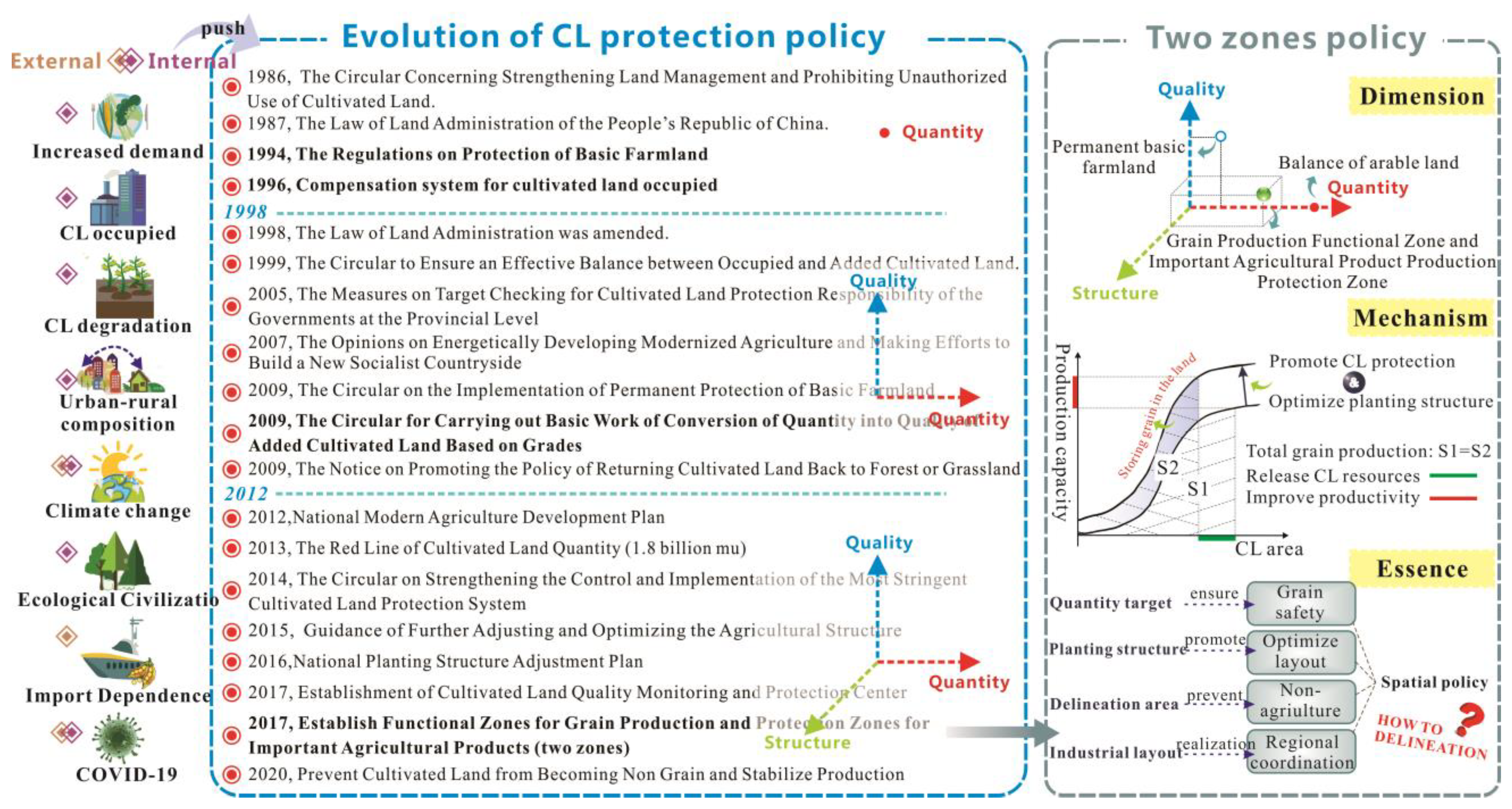
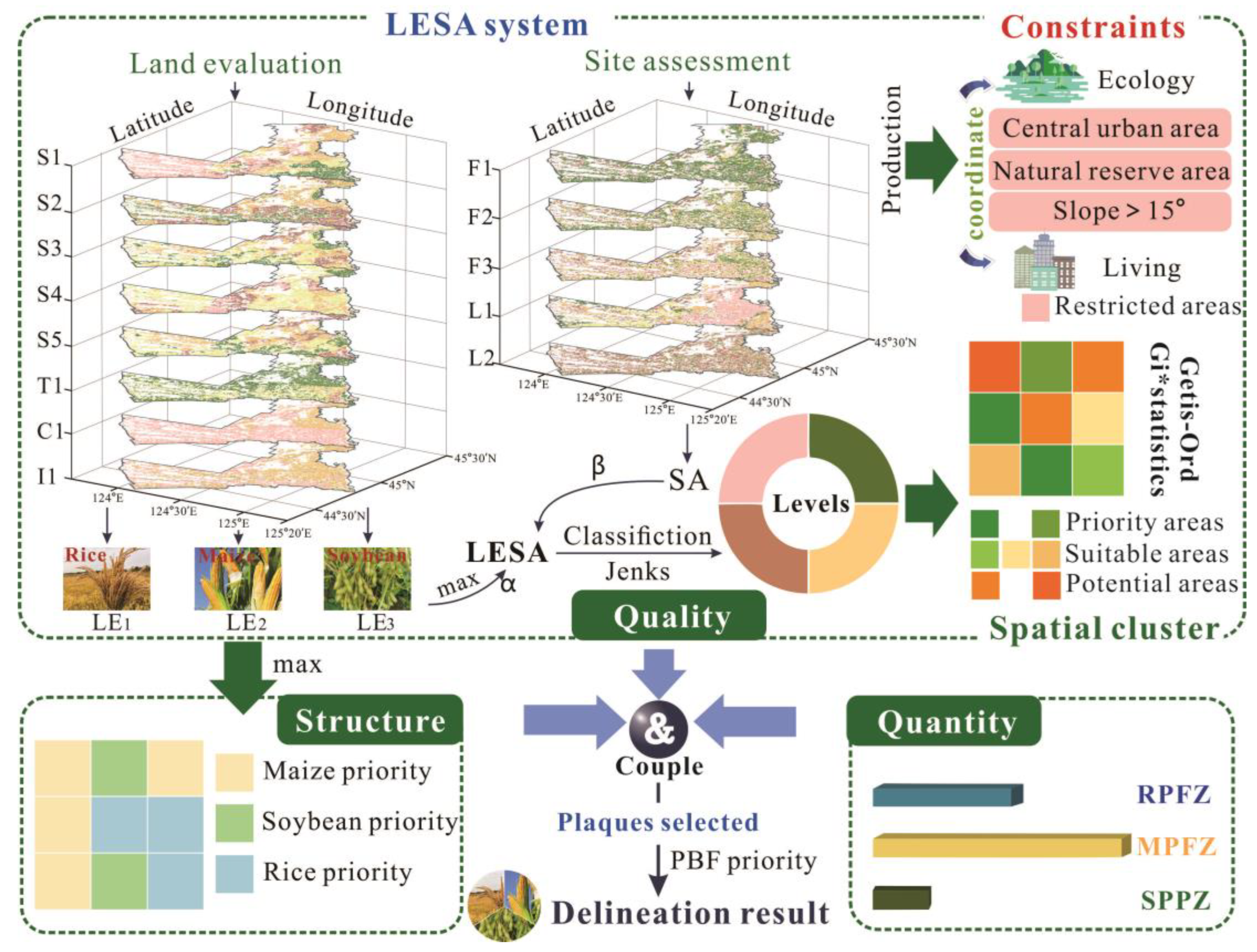
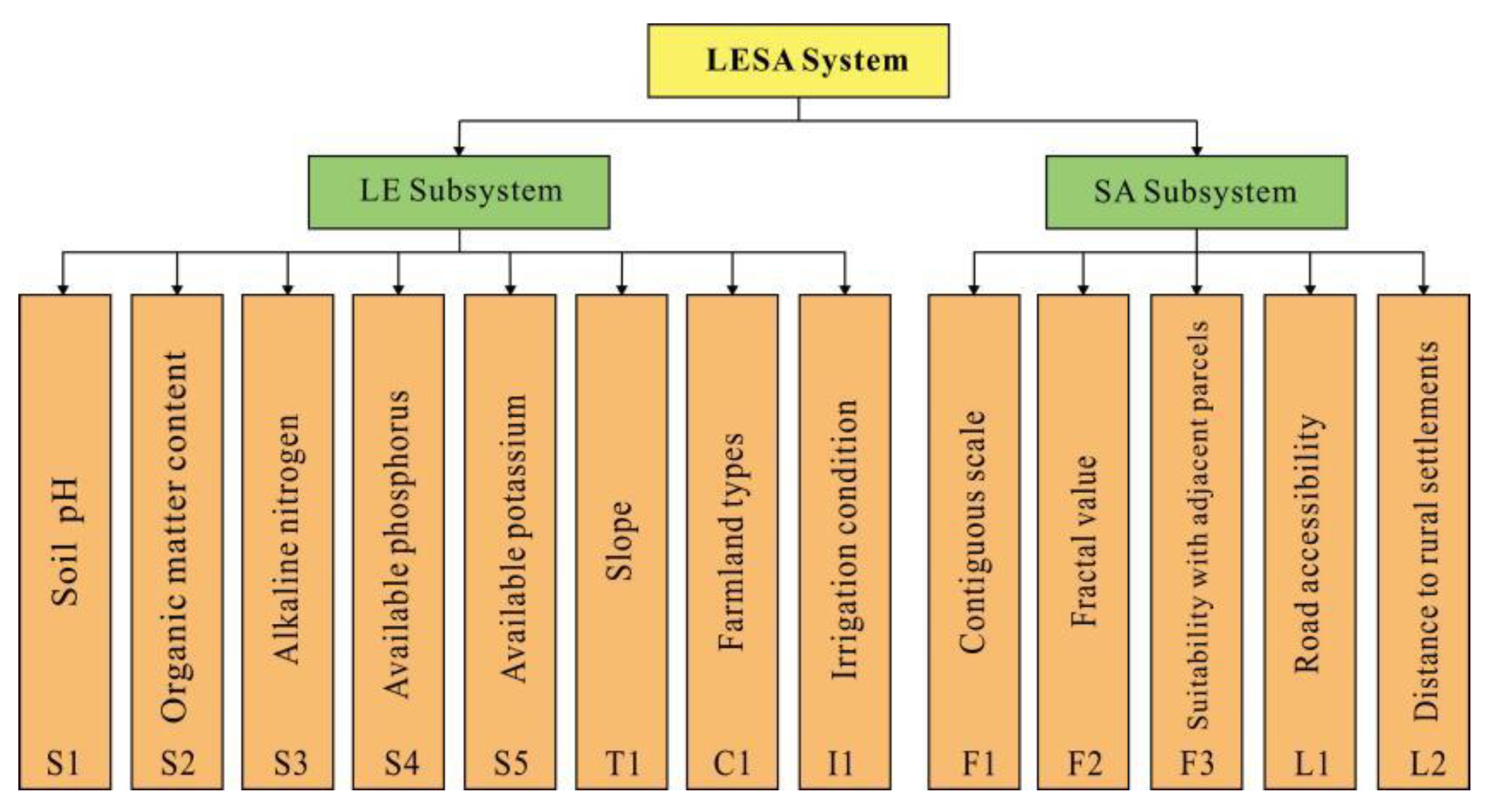


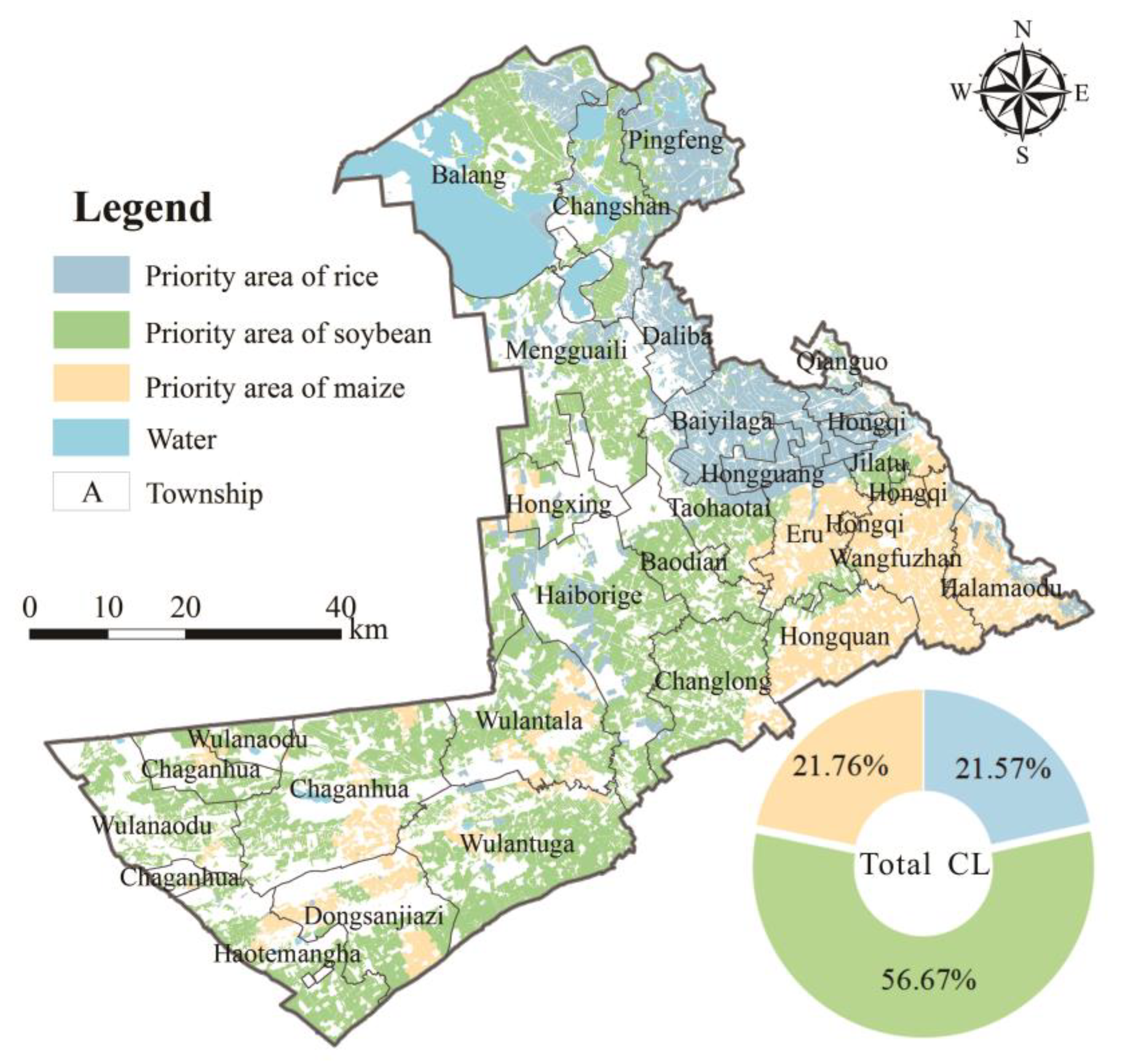
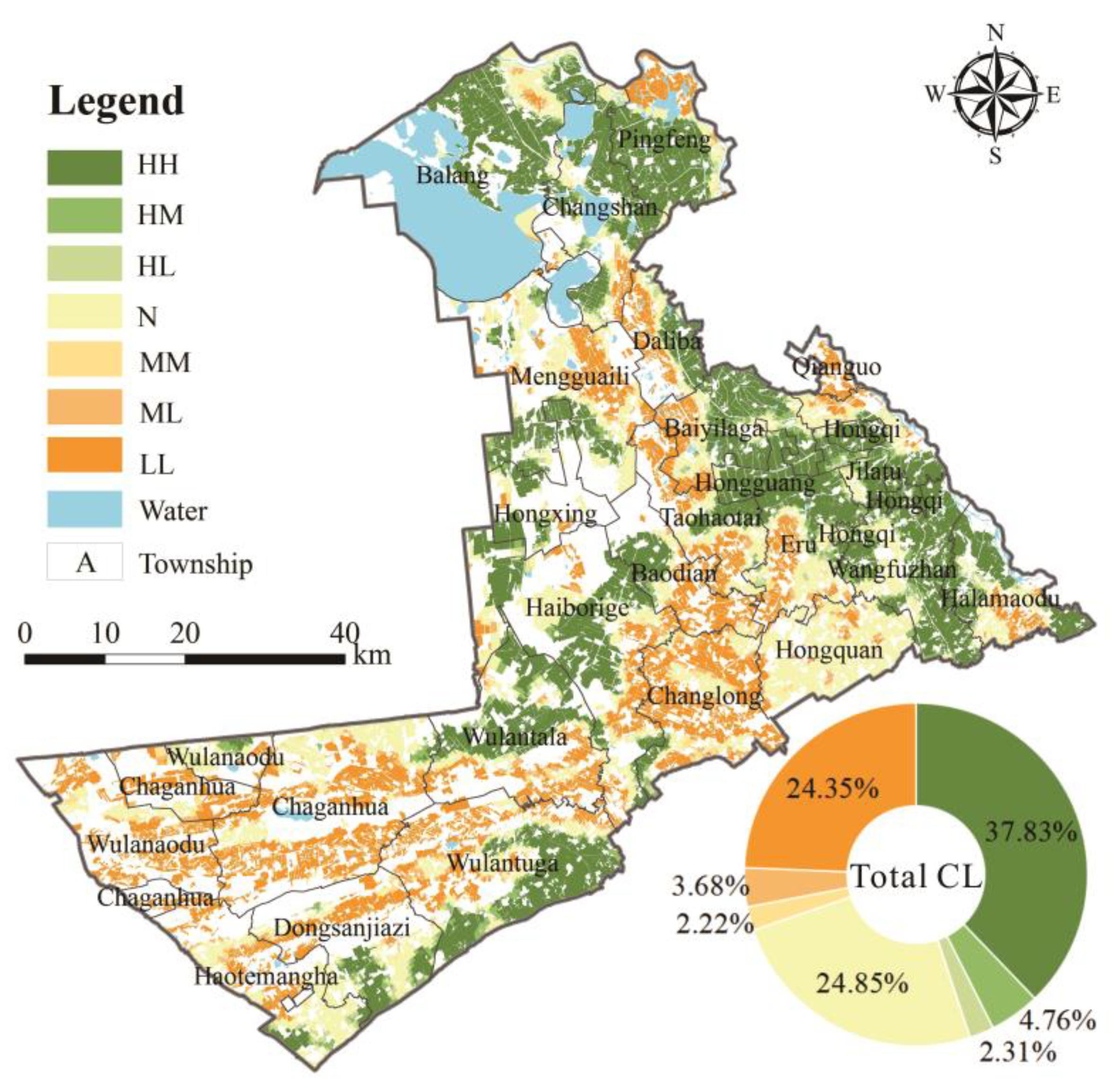
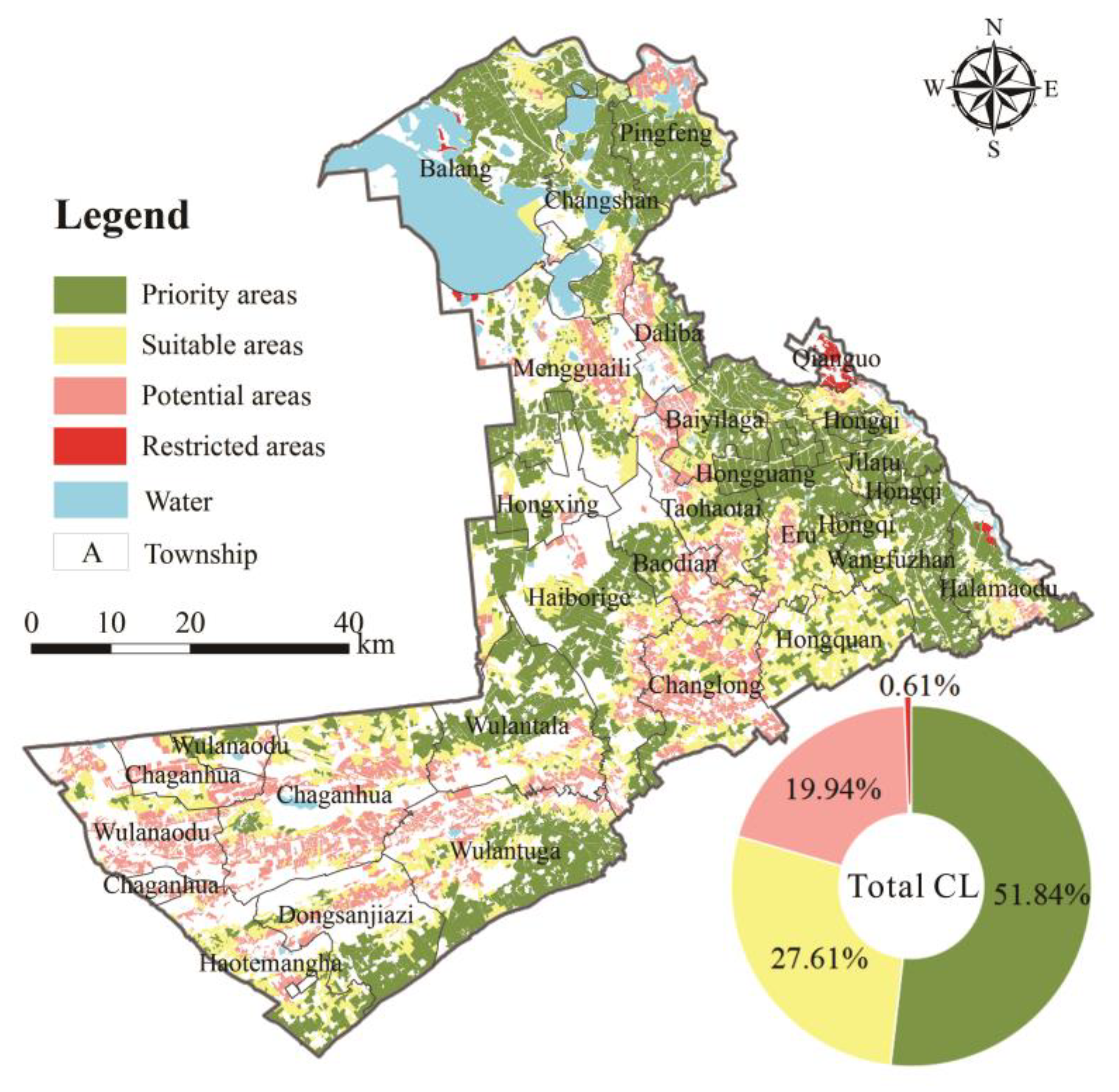
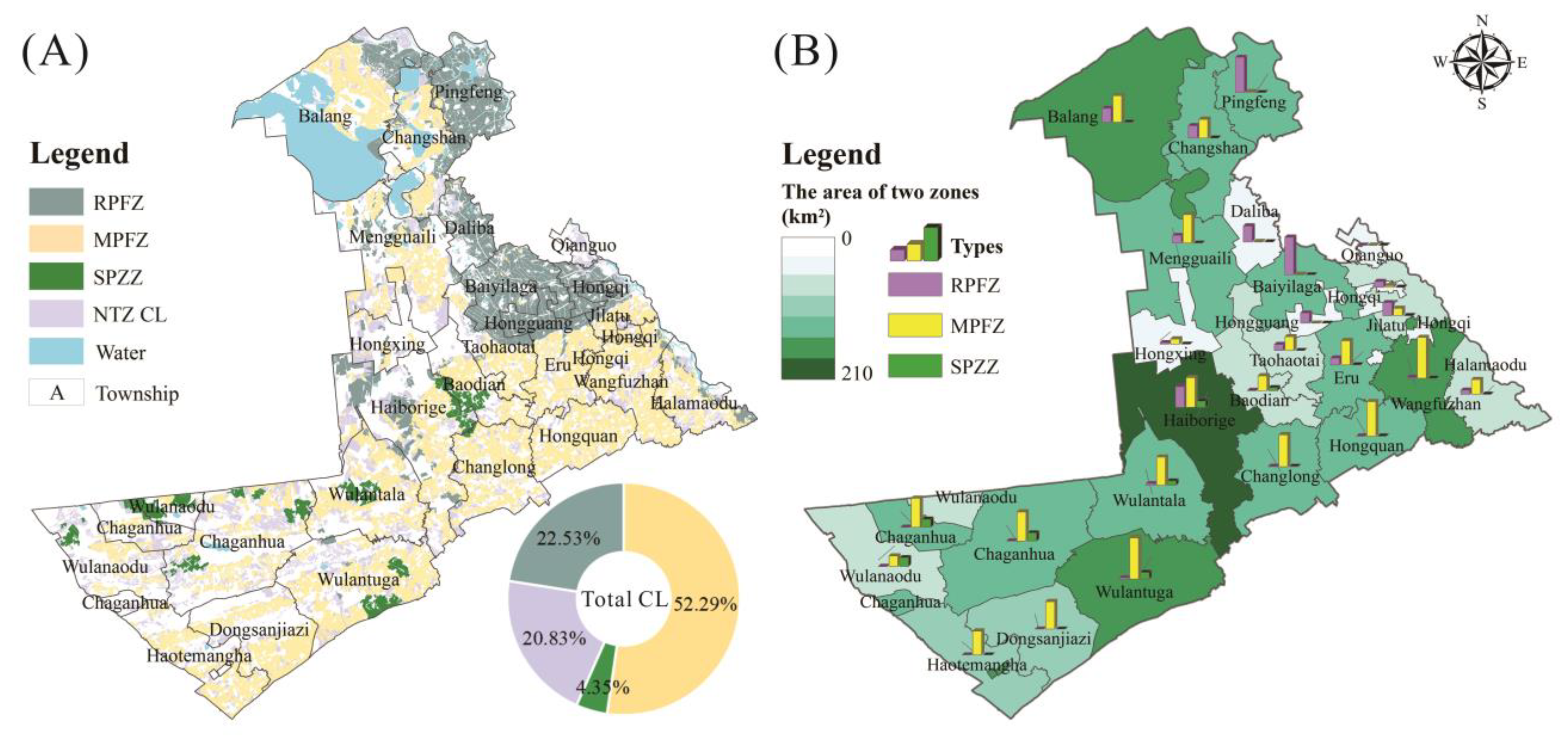

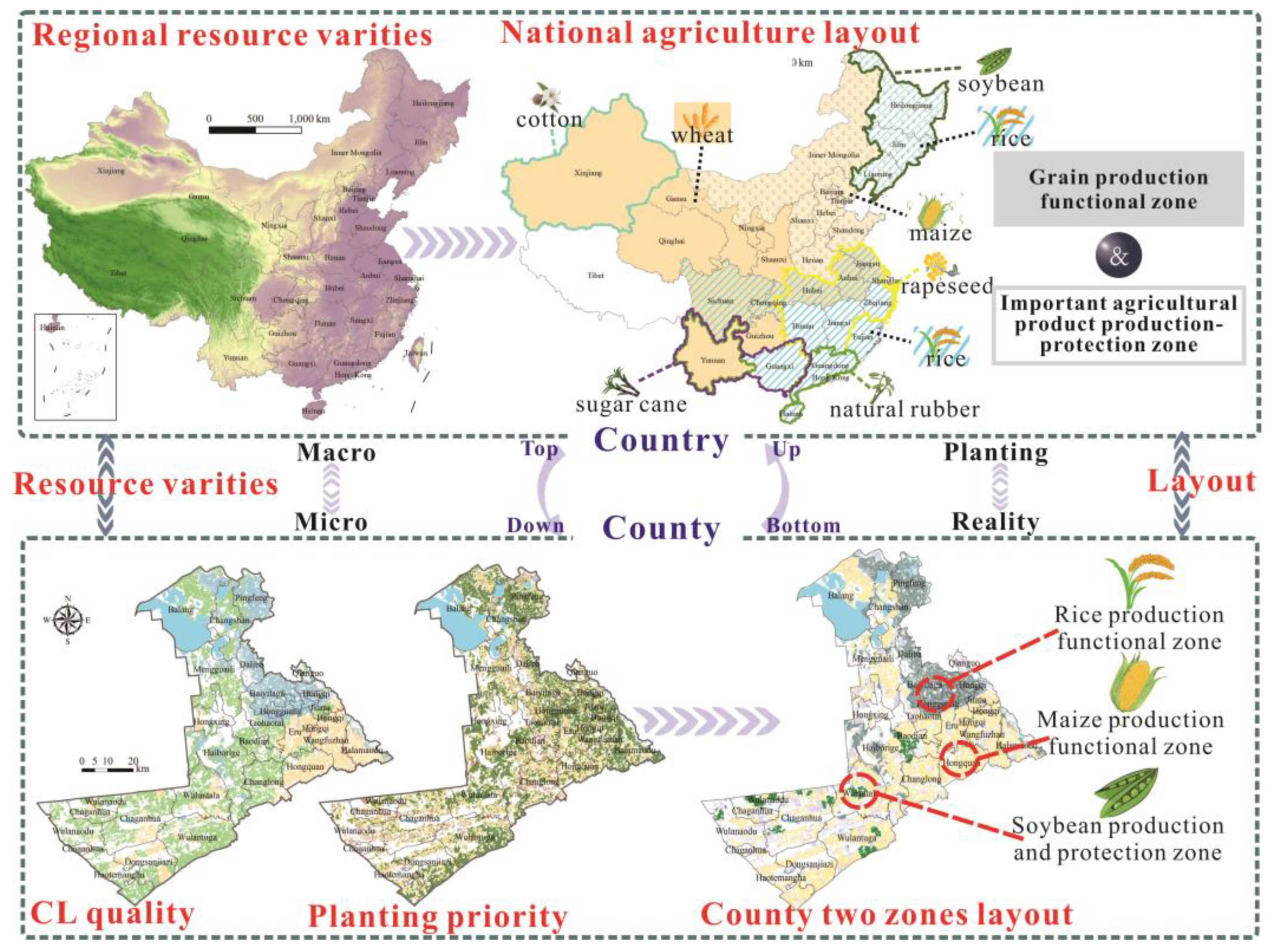
| Factor | SSF | Types | Threshold Value | |||
|---|---|---|---|---|---|---|
| a1 | a2 | a3 | a4 | |||
| S1 | SSF1 | C1 | 4 | 5.5 | 7 | 8 |
| C2 | 5.5 | 7 | 7.8 | 8.7 | ||
| C3 | 5 | 6.5 | 7 | 8.2 | ||
| S2 (g·kg−1) | SSF2 | CA | 10 | 40 | ||
| S3 (mg·kg−1) | SSF2 | C1 | 74 | 122 | ||
| C2 | 90 | 140 | ||||
| C3 | 80 | 130 | ||||
| S4 (mg·kg−1) | SSF2 | C1 | 6 | 15 | ||
| C2 | 4 | 12 | ||||
| C3 | 4 | 12 | ||||
| S5 (mg·kg−1) | SSF2 | C1 | 50 | 117 | ||
| C2 | 60 | 140 | ||||
| C3 | 44 | 112 | ||||
| T1 (°) | SSF3 | C1 | 2 | 5 | ||
| C2 | 5 | 8 | ||||
| C3 | 5 | 8 | ||||
| I1 | SSF4 | C1 | Good | Moderately good | Poor | |
| C2 | Good | Moderately good | Poor | |||
| C3 | Good | Moderately good | Poor | |||
| C1 | SSF4 | C1 | PL | IL | RL | |
| C2 | RL, IL | PL | ||||
| C3 | RL, IL | PL | ||||
| F1(ha) | SSF2 | PL | 0.05 | 1.00 | ||
| RL, IL | 0.20 | 3.33 | ||||
| Quality Level | LE1 | LE2 | LE3 | SA | ||||
|---|---|---|---|---|---|---|---|---|
| Area (ha) | Percent (%) | Area (ha) | Percent (%) | Area (ha) | Percent (%) | Area (ha) | Percent (%) | |
| Highest | 51,689.79 | 16.03 | 66,864.40 | 20.74 | 76,588.03 | 23.75 | 114,283.71 | 35.44 |
| High | 79,796.57 | 24.75 | 115,238.90 | 35.74 | 119,802.37 | 37.15 | 136,732.95 | 42.40 |
| Medium | 121,449.64 | 37.66 | 86,093.80 | 26.70 | 98,557.79 | 30.56 | 62,072.16 | 19.25 |
| Low | 69,530.22 | 21.56 | 54,269.12 | 16.83 | 27,518.02 | 8.53 | 9377.39 | 2.91 |
Disclaimer/Publisher’s Note: The statements, opinions and data contained in all publications are solely those of the individual author(s) and contributor(s) and not of MDPI and/or the editor(s). MDPI and/or the editor(s) disclaim responsibility for any injury to people or property resulting from any ideas, methods, instructions or products referred to in the content. |
© 2023 by the authors. Licensee MDPI, Basel, Switzerland. This article is an open access article distributed under the terms and conditions of the Creative Commons Attribution (CC BY) license (https://creativecommons.org/licenses/by/4.0/).
Share and Cite
Wu, S.; Wang, D. Storing Grain in the Land: The Gestation, Delineation Framework, and Case of the Two Zones Policy in China. Land 2023, 12, 806. https://doi.org/10.3390/land12040806
Wu S, Wang D. Storing Grain in the Land: The Gestation, Delineation Framework, and Case of the Two Zones Policy in China. Land. 2023; 12(4):806. https://doi.org/10.3390/land12040806
Chicago/Turabian StyleWu, Songze, and Dongyan Wang. 2023. "Storing Grain in the Land: The Gestation, Delineation Framework, and Case of the Two Zones Policy in China" Land 12, no. 4: 806. https://doi.org/10.3390/land12040806
APA StyleWu, S., & Wang, D. (2023). Storing Grain in the Land: The Gestation, Delineation Framework, and Case of the Two Zones Policy in China. Land, 12(4), 806. https://doi.org/10.3390/land12040806







